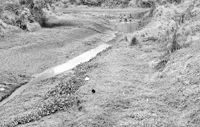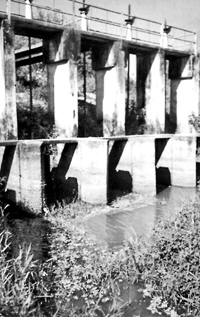|
Mavilaru anicut: Spills blood for water The Mavilaru anicut – the flash point which triggered the recent spate of hostilities between the Government and the LTTE – was little known till the LTTE decided to close its sluice gate and thus block water flowing to the Seruwila area.
The anicut was built in the 1960s by building a dam across two waterways namely the Verugal Aru and the Mavilaru which are tributaries of the Mahaweli River which flows to the sea at Koddiyar Bay in the Muttur area. The anicut has been the main source of water for the Muttur, Seruwila and Ichchalampattu district secretariat divisions.
The anicut which is situated in an “uncleared area” was closed by the LTTE on July 21 depriving water to more than 20,000 villagers. The LTTE said the anicut was shut because the Government had failed to give the green light for an ADB project to supply dinking water to the people living in LTTE-controlled areas and seeking a lifting of the embargo on essential goods to these areas. A senior irrigation officer in Trincomalee said prior to the recent incidents, things had been uneventful in the area and it was only the labourers who visited the anicut for the purpose of operating it. He said the water from the anicut was meant to irrigate an extent of 17,413 acres of paddy land. However due to the problems in recent months, the full extent of land was not cultivated for this season and it was reported that only a little more than 8000 acres were cultivated. The engineer said the gates of the anicut were only closed when there was heavy rain and threats of flooding. It was on July 20 the LTTE closed the Mavil Aru sluice gate, denying water to more than 15,000 families and thousands of acres of paddy land. The villages affected by the closure are Kallar,
Dehiwaththa, Thoppur, Seruvila, Serunuwara, Neelapola, Medagama,
Sirimangalapura, Pallikudirippu, Kiliveddy, Kanguweli, Maingama,
Thanganagar and Bharathipuram and those living there comprised a
multi racial community made up of Muslims, Sinhalese, Tamils. The
Mavilaru is the source of drinking water for these villagers as
well. Seruwila Raja Maha Viharaya chief incumbent Venerable Saranatissa Thera living in one of the most affected areas said when the crisis began, he had tried to contact the LTTE political wing leader S. Elilan to resolve it amicably. The Thera, the government representative on the local monitoring committee (LMC) of the SLMM for the Trincomalee District, requested the Engineers of the Irrigation Department to open the Mavil Aru sluice-gate but the engineers were prevented from going there by the LTTE. “I left my home number with their cadres but until today I have had no response,” the monk told The Sunday times. “This canal is the life line of the people of this area and we need the water urgently,” the Thera said. An SLMM monitor and an irrigation engineer too tried to reach the area two days later but could not make it due to the LTTE presence there. Things have become worse because the LTTE actions come in the middle of a drought that is prevailing in these areas. |
||||
Copyright © 2006 Wijeya Newspapers
Ltd. All rights reserved. |

